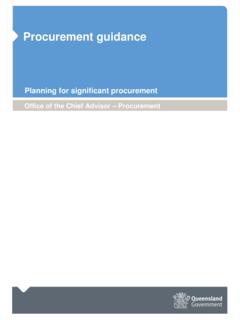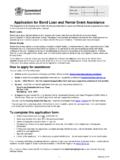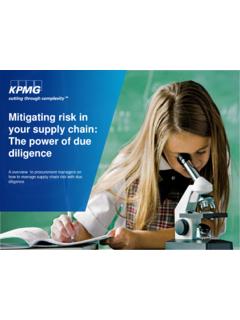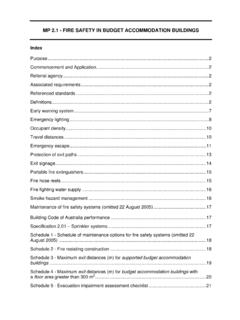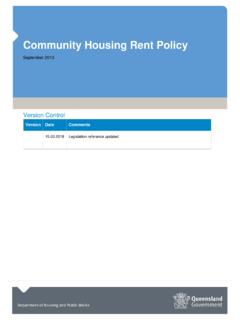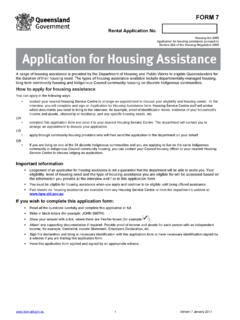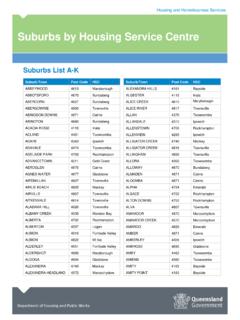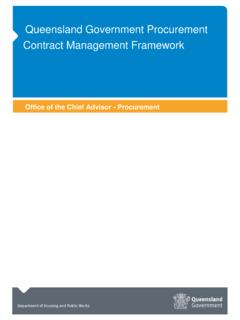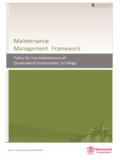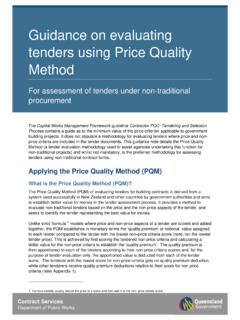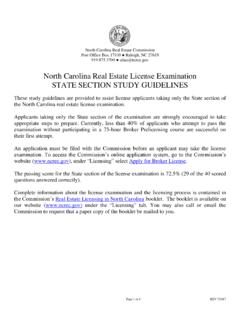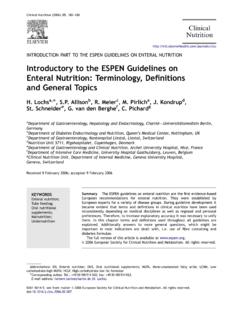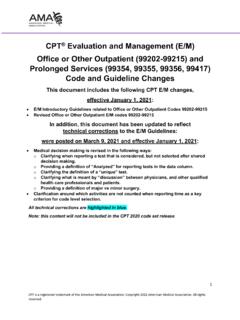Transcription of Queensland Plumbing and Wastewater Code Guidelines
1 Queensland Plumbing and Wastewater Code Guidelines For councils, plumbers, builders and developers A guideline to assist in the interpretation and application of the Queensland Plumbing and Wastewater Code Effective August 2008 QPW code Guidelines for councils, plumbers, builders and developers 2 - Introduction Queensland s ClimateSmart 2050 strategy has been developed to help the state address climate change. Through the ClimateSmart adaptation plan, the Queensland Government is working to ensure we have a secured future water supply. The Queensland Plumbing and Wastewater Code (QPW code) compliments the government s commitment to water savings through the implementation of a wide range of measures including sub-meters, expanded use of treated greywater and blackwater re-use trials. In an aim to help protect and conserve the state s water resources the Queensland Government will introduce a new version of the Queensland Development Code (QDC) Part MP which addresses water savings targets in class 1 buildings and a new QDC Part to address alternative water sources in commercial buildings.
2 These will commence on 1 January 2008. The QPW code compliments the QDC by providing for the approval of greywater treatment plants and setting the effluent quality criteria for greywater use. Water saving targets can now be achieved through effective utilisation of: household rainwater tanks communal rainwater tanks greywater treatment plants dual reticulation stormwater reuse. The purpose of this guide is to assist councils, plumbers, builders and developers to understand the technical and regulatory requirements for on-site Wastewater management systems, greywater use facilities and sub-meters. A full copy of the QPW code is available on the Department of Infrastructure and Planning website at QPW code Guidelines for councils, plumbers, builders and developers 3 - Important notes This document should be used as a guide to interpreting the QPW code and be read in conjunction with the QPW code.
3 All terms referred to in this guide have the same meaning as defined in the Plumbing and Drainage Act 2002 (PDA), Standard Plumbing and Drainage Regulation 2003 (SPDR) or a relevant Australian/New Zealand Standard. If a definition given in a relevant standard is inconsistent with the Act, Regulation or the QPW code, the legislation prevails. All relevant Australian and New Zealand Standards are applicable, unless otherwise outlined in the QPW code. Where there is an inconsistency, or the QPW code has additional requirements, the QPW code prevails. QPW code The QPW code has been designed to provide performance solutions to meet the statutory requirements of the PDA. This will maintain the standards set by the QPW code while allowing for innovation in materials and methods. This version of the QPW code was published on 23 November 2007 and commences by amendment to the SPDR on 1 January 2008. It replaces the previous version published by the former Department of Local Government, Planning, Sport and Recreation on 1 March 2006.
4 Because of our unique climate, the Wastewater handling and disposal requirements for Queensland sometimes differ from other Australian states. To answer this need, Queensland introduced the QPW code to provide for greywater use and on-site sewerage treatment within our state. Parts of the QPW code The QPW code is split into five distinct parts. These parts are designed to work together and should not be read in isolation. Part Title 1 On-site Wastewater management systems 2 Greywater use facilities 3 Land application systems 4 Water meters for new premises 5 Chief executive approvals QPW code Guidelines for councils, plumbers, builders and developers 4 - terminology and definitions The QPW code and PDA introduce several new definitions. It is important to be familiar with these definitions. The following is a limited guide to some of the definitions that are relevant to the QPW code. However these are a guide only and the precise wording of the definition in the QPW code or PDA should always be consulted.
5 On-site Wastewater management system a system installed on premises that receives and treats Wastewater generated on the premises and applies the resulting effluent to an approved disposal or re-use system (including an on-site sewerage facility but excluding a greywater use facility). Land application system a greywater application area associated with a greywater use facility or a land application area associated with an on-site sewerage facility. Meterable premises which means each lot within a community title scheme, including the common property, in a water service provider s area, and the sole occupancy unit of a class 2, 4, 5, 6, 7 or 8 building in a water service provider s area, and each storey of a class 5 building in a water service provider s area where the building consists of more than one storey and sole occupancy units are not identified at the time of the building s Plumbing compliance assessment. Sole occupancy unit which means a room or other part of the building for occupation by one or a joint owner, lessee, tenant or other occupier to the exclusion of any other owner, lessee, tenant, or other occupier.
6 This could be a dwelling, a room or a suite of associated rooms in a building classified under the Building Code of Australia as a class 2, 4, 5, 6, 7 or 8 building. A Sole occupancy unit also includes any part of the building that is a common area or common property. Water meter a device, including equipment related to the device, for measuring the volume of water supplied to premises. Related equipment could include a pulse meter or an automatic meter reader and associated technology or similar devices. The purpose is to ensure the water service provider controls the equipment necessary to ensure the accurate reading of the device for billing purposes. Public area A public area means an area which the public have access too. This is an inclusive definition , it is not limited to the footpath and may include public car parks, walkways, etc, provided the public ordinarily has access to them. Common area means an area of common property. This could include an area of the common property that is leased to a another person.
7 Storey means a space within a building which is situated between one floor level and the floor level next above, or if there is no floor above, the ceiling or roof above. It does not include a space that contains only a lift shaft, stairway or meter room or a bathroom, shower room, laundry, water closet, or sanitary compartment or accommodation intended for not more than three vehicles or combination, or a mezzanine. QPW code Guidelines for councils, plumbers, builders and developers 5 - Alternative or new materials The QPW code has been designed to foster innovation and creativity. It should not be interpreted in a manner which prevents the use of materials or products not specifically referred herein. Alternative or new materials and products not covered by the code or the Regulation should be submitted to a JAS-ANZ accredited agency for certification or approval. Associated legislation It is important to be aware that compliance with the QPW code or a relevant standard may not be the only requirement.
8 In addition, it is important to realise the limitations of the QPW code. The QPW code does not operate in isolation. Other state and commonwealth legislation such as State Acts, IDAS codes, council planning schemes and local laws may impose additional requirements. Legislation and standards to consider may include: Body Corporate and Community Management Act 1997 (BCCM) Building Act 1975 Building Regulation 2006 Environmental Protection Act 1994 Environmental Protection (Air) Policy 1997 Environmental Protection (Noise) Policy 1997 Environmental Protection Regulation 1998 (EP Regulation) Environmental Protection (Waste Management) Policy 2000 Environmental Protection (Waste Management) Regulation 2003 Environmental Protection (Water) Policy 1997 (EPP (Water)) Integrated Planning Act 1997 (IPA) Plumbing and Drainage Act 2002 (PDA) Standard Pluming and Drainage Regulations 2003 (SPDR) Public Health Act 2005 Water Supply (Safety and Reliability) Act 2008 Water Act 2000 (Water Act)
9 Water Regulations 2002 Water Efficiency Labelling and Standards Act 2005 Building Code of Australia Plumbing Code Australia Queensland Development Code Australian and New Zealand Design Standards Australian Technical Specifications For example, with regard to the use of on-site sewage treatment plants, the PDA restricts the approval of these plants to those that are designed to service 20 or less equivalent persons. For those plants designed to service 21 or more equivalent persons a separate approval will be required under the Environmental Protection Act 1994 (EP Act) from the Environmental Protection Agency. QPW code Guidelines for councils, plumbers, builders and developers 6 - Standards The following standards are referenced in the QPW code and are applied provisions for the purposes of the Regulation. On-site domestic Wastewater treatment units Part 1:Septic tanks AS/NZS On-site domestic Wastewater treatment units Part 2:Waterless composting toilets AS/NZS On-site domestic Wastewater treatment units Part 3:Aerated Wastewater treatment systems AS/NZS 1547 On-site domestic Wastewater management.
10 Meters for Water Supply Cold water meter Meters for Water Supply Combination meters Meters for Water Supply Water meters with integral dual check values Meters for Water Supply In-service compliance testing Meters for Water Supply Water meters with two integral single check values. 1 On-site Wastewater management systems Scope The QPW Code sets out the technical requirements for the sustainable management, site and soil evaluation, design, installation and operation of on-site Wastewater management systems in areas not served by a sewerage system. Application Part 1 of the QPW code applies to on-site sewerage facilities serving premises where the sewage is predominantly of domestic origin and where the facility includes a sewage treatment works having a peak design capacity to treat sewage of 20 or less equivalent persons. It applies to any part of an on-site sewerage facility of the above peak design capacity installed on a premises as part of a common effluent drainage (CED) scheme.
